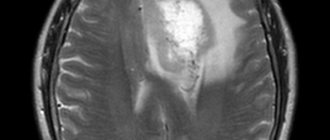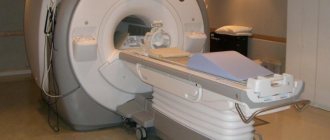According to the standards of the Ministry of Health of the Russian Federation, every child at the age of 1 month must be examined by a surgeon, neurologist, orthopedist-traumatologist, and ophthalmologist. By performing an ultrasound on a child, specialists will be able to identify developmental abnormalities, hidden pathologies in the structure and location of internal organs that were not detected immediately after birth.
Modern pediatrics recommends that the first ultrasound of a baby be performed in the maternity hospital, immediately after birth, and the next one 1-1.5 months after birth in a children's clinic.
The procedure has no contraindications and there are no complications from it. Ultrasound diagnostics is used in pediatrics as the safest non-invasive painless informative method for examining the health status of children.
Why should a baby have an ultrasound?
His tasks:
- exclude congenital malformations, and also check the closure of fetal communications (patent foramen ovale and ductus arteriosus);
- examine the baby’s brain, exclude or detect developmental defects;
- make sure the correct shape, size, location of the internal organs of the gastrointestinal tract, kidneys, organs of the reproductive and urinary system of the baby;
- determine orthopedic birth defects, including hip dysplasia, hip dislocations and subluxations, and the condition of the cervical vertebrae.
At what month should the next ultrasound examination of the child be done? This will be advised to parents by the pediatrician and specialized specialists who are seeing the baby.
Is ultrasound harmful for children and how often can it be done?
Carrying out research using ultrasound is absolutely harmless to the human body. This is confirmed by the fact that, unlike, for example, radiologists, the ultrasound diagnostic doctor does not wear any protective equipment. Yes, sometimes ultrasound specialists work with gloves, but this is only to avoid infection.
Unlike X-ray examinations, the frequency and frequency of ultrasound examinations is not limited in any way. If necessary, for example, to monitor the dynamics of the development of the disease or the effectiveness of the treatment, ultrasound examinations of the child can be performed multiple times, even within one day.
When is an ultrasound performed on a newborn?
Ultrasound as part of screening of newborns and infants at the age of 1 month is aimed at the early detection of hidden pathologies. Not all developmental defects are diagnosed visually; the condition of internal organs and joints is subject to more detailed study using ultrasound diagnostics.
Over 30 years of observation, doctors from the leading countries of the world have not received confirmation that ultrasound has a negative effect on the human body. It is given to children for:
- identifying pathologies;
- clarification of the diagnosis;
- monitoring the effectiveness of therapy.
Why exactly 1 month?
It is during the period of 1 month that many pathologies and diseases can be identified that can be effectively treated and corrected if detected in a timely manner. Parents and the child are advised after the ultrasound by a pediatrician, neurologist, surgeon, or orthopedist.
An ultrasound examination of a 1-month-old baby is recommended by the Ministry of Health, but parents can refuse it if they wish. Some types of research may not be possible in the future. For example, brain examinations using ultrasound through an open fontanel are only possible in children from birth to 1 month. The joints are clearly visible because the bones are not yet strong, and ultrasound passes through them.
An ultrasound of which organs should be performed on a newborn?
Ultrasound examinations are mandatory in the Russian Federation for a one-month-old baby:
- Brain. It is called neurosonography and is carried out through the large fontanel on the head. The task of diagnosis is to identify congenital developmental defects or pathological changes due to difficult childbirth.
- Abdominal and pelvic organs, including kidneys, liver and spleen, pancreas, gall and bladder, ureters.
- Hip joints to ensure the absence of dysplasia, dislocations, subluxations of the femurs.
- Hearts. Echocardiography or ultrasound of the heart of a newborn is mandatory to exclude various pathologies.
In some cases, especially with vomiting, an ultrasound scan of the pylorus is performed. This allows us to exclude hypertrophic pyloric stenosis.
Indications for ultrasound of a child at 1 month
Ultrasound of the brain:
- prematurity;
- traumatic injuries;
- suspected developmental defects;
- ischemia;
- neurological symptoms;
- suspicion of an inflammatory process.
The study is also carried out for preventive purposes, to identify possible pathologies. It is especially important to conduct a timely ultrasound of the brain if there is frequent regurgitation or disproportionate growth of the child’s head, excessive excitability or lethargy.
Abdominal ultrasound:
- non-compliance with the norm in laboratory urine blood tests;
- bloating, enlarged liver;
- loose stools, yellowing of the skin;
- discomfort, the baby cries, does not want to eat.
Ultrasound of the hip joints:
- possible genetic inheritance;
- infectious diseases affecting joints;
- multiple pregnancy in mother;
- one leg is shorter than the other;
- clicking or other sounds when the leg is abducted;
- asymmetric folds on the buttocks.
Ultrasound of the heart:
- suspected pathology;
- blue discoloration of the nasolabial triangle;
- low weight for no reason;
- low body temperature of unknown etiology;
- heredity.
Ultrasound is an informative diagnostic method that does not harm children of any age. Therefore, it is recommended to carry it out at the age of one month, not only for indications, but also for the purpose of screening and prevention. Most modern parents are worried about their children and undergo an ultrasound scan at 1 month in a timely manner. The procedure does not take much time, about 30–40 minutes.
Features of ultrasound examination at myMEDIKus
Our highly qualified diagnosticians perform routine and urgent ultrasound examinations for children in Moscow, as well as in the Moskovskoye, Peredelkino Blizhneye, Aprelevka, Solntsevo districts. To ensure a comfortable stay in the clinic and not to instill in the baby a fear of medical procedures, examination and diagnosis are carried out:
- only in the presence of parents;
- through constant communication, games and jokes to distract the baby;
- followed by rewarding children for good behavior.
Such harmless manipulations give accurate results without disturbing the child’s nervous system.
Our medical center offers a complex of modern ultrasound examinations, which help to obtain a complete picture of the child’s health condition, timely detect and eliminate all possible abnormalities in the functioning of his body. Still have questions? For additional advice, please call.

4D ultrasound: complete clarity in real time
Yesterday's “scratched” ultrasound images, which until recently seemed like a curiosity, are outdated. And as soon as they were replaced by accurate and color 3D ultrasound, medical technologies overtook themselves - 4D ultrasound shows simply stunning results. It allows you to “look after” your baby in real time. Even before the birth of the long-awaited baby, the mother can see not only how his nose wrinkles, but also how his legs and arms move.
The number “4” in the term “4D” indicates that video is added to the image.
And real-time mode is by no means an exaggeration. Yesterday's super photographs taken on a 3D ultrasound machine certainly cannot be compared with intrauterine video, which can be obtained using the latest technology.

Advantages of 4D ultrasound
4D ultrasound during pregnancy provides a lot of diagnostic opportunities, without leaving close parental concerns unattended.
The main advantage of the new technology is its convenience and display accuracy. In addition, with outdated technologies, it was very difficult for a non-specialist to see anything. And when the doctor told you that the baby had two arms and two legs, you had to literally take his word for it, touched by the incomprehensible light spot on the black and white printout. Now you can not only look at how these legs look, but also notice how the baby waves his hand or yawns.
How dangerous is 4d ultrasound during pregnancy?
No matter how many inventions medicine is enriched with, there will always be those who will argue: the procedure is harmful, it’s better to guess with cards.
The most common myth about the dangers of ultrasound:
During the procedure, the fetus behaves very restlessly: it kicks, tosses and turns, causing discomfort to the woman. The scanner clearly harms the baby and his mother!
Debunking the Myth:
Try moving your finger over your stomach as if it were an ultrasound scanner. The baby will definitely kick you back with the same intensity as during an ultrasound.
Times change, but stereotypes remain the same. But this makes four-dimensional ultrasound during pregnancy, like its predecessors 2D and 3D, neither harmful nor beneficial. This is simply a diagnostic procedure, thanks to the accuracy of which many diseases are nipped in the bud, many worries are dispelled, and many mothers joyfully watch the video in anticipation of the birth of the baby.
When do doctors prescribe 4D ultrasound?
If suddenly at 24 weeks of pregnancy the doctor sent you for a 4D ultrasound of the fetus, this does not mean that there are any threats. It's just time to see what is visible to the eye. Your baby's external organs have developed enough to understand if everything is okay with them.
But the doctor must also make sure that you do not have:
- Oligohydramnios or polyhydramnios;
- Entwining the baby's neck with the umbilical cord;
- Threats of abortion;
- Hypotrophy.
And the 24th week of pregnancy is the most fertile time for this. You and the doctor can already see a real baby, very slightly different from a newborn in height and weight.
How many times during pregnancy can a 4D ultrasound be done?
As in all good endeavors, it is better to stick to the golden mean. Visiting an ultrasound specialist’s office every week is clearly overkill. But going there only once before giving birth is a big chance of missing a dangerous pathology. The golden mean in this area is traditionally considered to be a number from 3 to 5.
- The first ultrasound can confirm the very fact of conception.
- The second procedure is recommended at 11-12 weeks;
- Sometimes at 16 weeks a third fetal examination is done;
- Fourth - at 22 weeks;
- The last ultrasound traditionally takes place around 32 weeks.
Each stage is fraught with certain risks, which are better to find out immediately in order to avoid complications.
A nice addition: 4D ultrasound after pregnancy
After the birth of your child, new technologies will not disappear from your field of vision. 4D ultrasound is successfully used by most branches of medicine, from urology and gynecology to ophthalmology and endocrinology. Modern equipment diagnoses pathological conditions of the prostate gland, cystic formations of the ovaries, damage to the retina and eyeball, vascular and oncological disorders.
Sign up for an ultrasound by phone +7 (495) 649 69 88
Make an appointment using the form:
Our services:
- Fetal CTG
- Observation in the postpartum period
- Expert ultrasound
You may be interested in:
- Ultrasound: postpone or sign up?
- Bad Syndrome
- Bandage: to wear or not
| Torch infections - a horror story for pregnant women or a real threat? >> |
Unscheduled ultrasounds

At any age, a child should attend an ultrasound examination as soon as possible if the following symptoms are present:
- regular nausea and vomiting;
- sleep disorders;
- decreased appetite;
- low mood;
- pain of any location;
- chronic fatigue;
- disruptions of the gastrointestinal tract (diarrhea, constipation);
- dizziness and fainting;
- prolonged increase in body temperature;
- heart rhythm disturbances;
- pathological discharge from the genitals;
- urinary disorders (frequency, retention, pain, impurities or blood in the urine);
- problems at school: poor performance or difficulties communicating with others;
- disturbances in concentration.
What does an ultrasound of the heart show?
During echocardiography, the doctor pays attention to the condition and development of the internal structures of the heart, its valves and chambers. Also, modern ultrasound machines, additionally equipped with Doppler ultrasound, make it possible to examine intracardiac blood flows, the root and arch of the aorta, the valve and branches of the pulmonary artery, coronary vessels and pulmonary veins.
However, first of all, with echocardiography, attention is paid to the size of the heart cavities, the thickness of the walls, as well as the outline and functioning of the valves and heart muscle (myocardium). Deviations from the norm of certain parameters may indicate various diseases and congenital heart defects.
How long does the procedure take?
The duration of the examination depends on its volume (one or several organs), the severity of the pathology, the age and character of the child being examined. If a small child is scared and crying, of course, first of all, he needs to be calmed, distracted, laid down and examined.
For older children, we explain that the procedure is completely painless, they calmly lie down and allow further examination. On average, one organ takes up to 5 minutes; a complete examination can take up to 30 minutes. Of course, with more severe pathologies, the examination time may increase.
What is cardiac ultrasound and how is it performed?
Ultrasound diagnostics is based on the principle of echolocation. To obtain reliable information, the doctor applies a special water-based gel to the skin. And only after that a special sensor touches the examination site. This is done in order to get rid of the air gap that prevents supersonic waves from penetrating through the tissue.
The strength of these waves is very small, that is, such radiation simply cannot harm health. At the same time, the magnitude of these waves is quite sufficient for them to reflect from tissues and organs and transmit a return signal (echo) back to the sensor. The information received is sent to the ultrasound machine and displayed on the monitor in the form of an image. The doctor can only decipher it and write a conclusion.
Usually such actions take a little time. Just 3-5 minutes and information about the health of your baby’s heart is already in your hands. However, do not be alarmed if the ultrasound is delayed for a longer period. The examination method is absolutely harmless and safe. Therefore, even 20–40 minutes of studying the structure of your baby’s “motor” will not in any way affect his future well-being.
What to take with you to the ultrasound room
In order to perform an ultrasound of the heart, the baby does not require additional preparation, as, for example, when examining the abdominal cavity. But there are some things you just need to take with you:
- Referral for ultrasound and outpatient card of the child. It also doesn’t hurt to know the exact weight and height of the baby at the time of the examination. All this will help determine whether the growth and development of the heart is normal.
- A diaper and some wipes. You will place your baby on the diaper, and use napkins to remove any remaining gel from the skin.
- Pacifier or bottle with food/water. To obtain the most reliable information about the work of the heart, it is necessary that the baby behave calmly during the examination. And what can calm a baby better than his favorite “yummy”?
- When repeating an ultrasound of the heart, it is imperative to have on hand the results of all previous examinations.
Also remember that your baby will need to be undressed for the examination. Therefore, wear the most comfortable and easy-to-remove clothes. Otherwise, you will have to spend quite a lot of time and effort to calm the child. If you decide to visit several doctors in one day, and also get tested, then start your “round” with the ultrasound room. Remember, the calmer the baby is, the more complete the picture of his health will be and the faster the examination will be completed!










